From the Jayco Forum:
The campground where I am hosting right now had a problem with several campers in one area with complaints of getting shocked (or tingled) when touching outside metal parts of their rigs. The campground called in an outside electrician and he traced the problem back to one older rig. When it was plugged in to the pedestal the problem existed for all others on that same circuit. He was told not to plug in until his problem was solved. This was just yesterday so I haven’t heard what his internal problem was. The campground circuit was checked completely at each pedestal and found not to be the problem.
Part 1: What’s happening…
I’ve talked to a few of my EE buddies about this situation, and we all agree that if you’re seeing this same ground voltage at multiple RVs plugged into different pedestal outlets, then the likeliest cause is a compromised Ground-Neutral bond in the campground’s service panel leg that’s feeding all those pedestals. This can be very dangerous since a ground fault in a single RV can be reflected to everyone else on the campground loop.
Also be aware that because UL won’t allow the EGC ground to be disconnected by any safety device, even an advanced EMS surge protector can’t disconnect you from a reflected hot ground (but it will shut down your interior power), nor will any GFCI trip and protect you no matter where it’s located in the circuit.
Testing, Testing…
The best way for the campground to test for a proper impedance EGC ground is to use a ground loop impedance tester such as a SureTest Analyzer or Amprobe INPS-3. These are too expensive for a casual user since they cost around $300, but certainly any campground or electrician should be able to afford one. I’m advocating that all campgrounds are checked for ground loop impedance every season, or anytime a pedestal has been damaged and repaired or replaced. But it’s slow going because of the “it’s never happened to me” crowd. However, I get emails about this all the time and have mocked up a demonstration to prove how this works and ways to measure it. —Mike
Part 2: What is a Reflected Hot-Skin Voltage?
This is a bit tricky to understand, but it happens more than you might think. In a campground, the feeder conductors typically daisy-chain from pedestal to pedestal, fed by a common circuit breaker in the main service panel. If there’s an interruption in the grounding conductor path for any reason (corroded or loose connection in one of the pedestal, or a broken wire underground, or even a disconnect of the bond to the neutral in the service panel), all RVs that are downstream of the ground break will have their chassis connected together, but none of them will be grounded (bonded) to the main service panel.
All for one, and one for all…
So, in that case, if a single RV has something like a fried electric element in the water heater, without proper grounding that 1 or 2 amps of fault current can easily turn into 80 to 120 volts of hot-skin potential. And that same voltage can be “reflected” to the other 6 or so pedestals on that feeder. So, if one RV has a fault current that turns into a hot-skin voltage, all the other RVs in the area can have the same voltage if there’s no service panel bond/ground.
Is a reflected hot-skin voltage the campground’s fault?
Well, yes, it is. If the campground doesn’t properly maintain and test their pedestals for proper grounding with something like a SureTest Analyzer, then ANY RV that’s plugged into a pedestal can cause ALL the RVs on that feeder to develop a reflected hot-skin voltage. So, simply removing the offending RV from the campground does not correct the real problem of a non-existent service panel bond in the campground electrical system.
But without a standardized campground maintenance and test SOP (Standard Operating Procedure), this dangerous condition can be unnoticed until an RV with a large fault current plugs in. And that’s what can endanger all the other campers in that area of the campground connected to that common feeder circuit.
Let’s play safe out there…. Mike

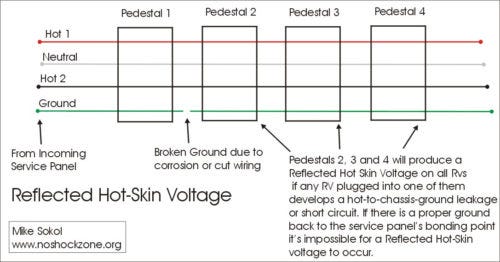



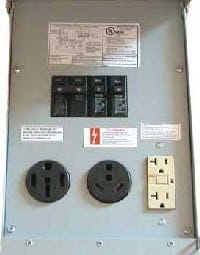
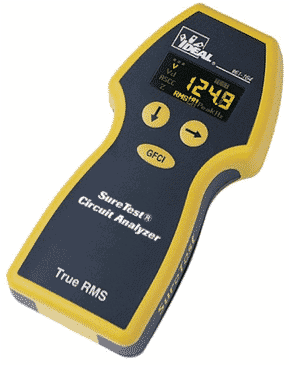
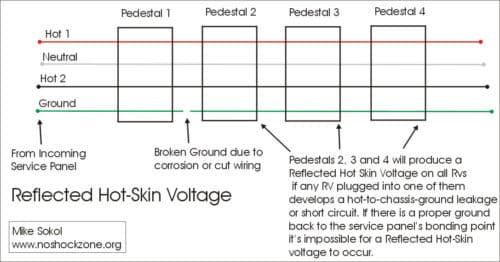
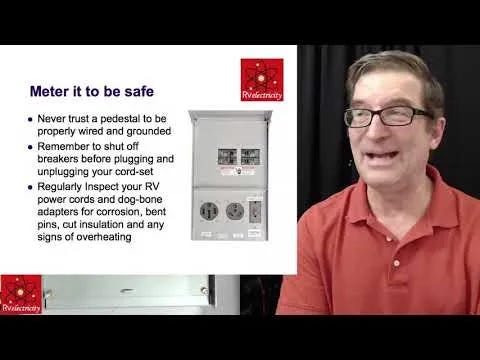


I had a situation similar to this at a campground that was traced back to an older rig plugged into a 30 amp circuit. When he switched to his 50 amp cord and plugged into the same pedestal 50 amp circuit the problem went away.
There have been deaths resulting from this condition at marinas.